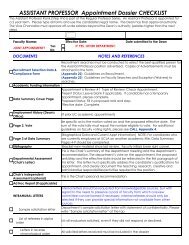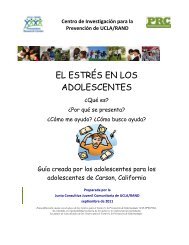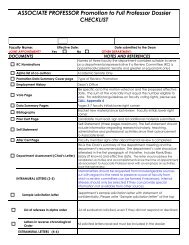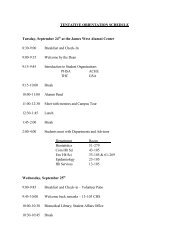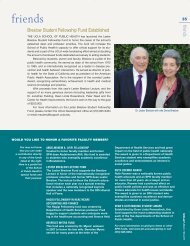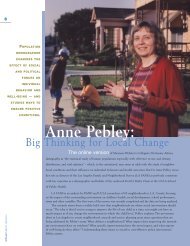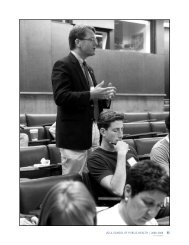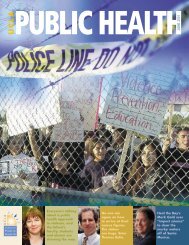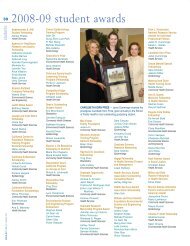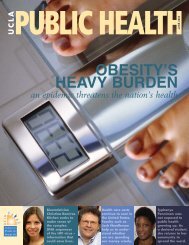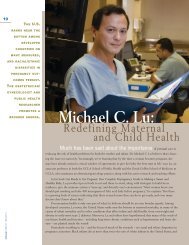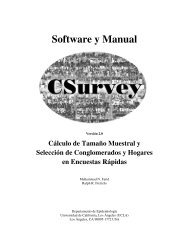A BROADER VIEWOF HEALTH: - UCLA School of Public Health
A BROADER VIEWOF HEALTH: - UCLA School of Public Health
A BROADER VIEWOF HEALTH: - UCLA School of Public Health
You also want an ePaper? Increase the reach of your titles
YUMPU automatically turns print PDFs into web optimized ePapers that Google loves.
<strong>Health</strong> Impact Assessment <strong>of</strong> Santa Monica Airport Teaches<br />
<strong>UCLA</strong> Pediatric Residents to Broaden View <strong>of</strong> Physician’s Role<br />
For the pediatric residents training at Ronald Reagan<br />
<strong>UCLA</strong> Medical Center, it was an unusual project – but one<br />
that reflects a recognition that social and environmental<br />
conditions are every bit as important to children’s health<br />
as what occurs in a clinical setting.<br />
In response to concerns from members <strong>of</strong> the community<br />
surrounding Santa Monica Airport, the 10 pediatric<br />
residents – part <strong>of</strong> the <strong>UCLA</strong> Community <strong>Health</strong> and<br />
Community leaders meet with <strong>of</strong>ficials to discuss concerns<br />
about potential health impacts from Santa Monica Airport.<br />
Advocacy Training (CHAT) program – conducted a health<br />
impact assessment (HIA) <strong>of</strong> the Santa Monica Airport to<br />
organize, analyze and summarize existing information on<br />
the potential health impacts <strong>of</strong> the airport’s activity related<br />
to three issues: air quality, noise and the lack <strong>of</strong> an airport<br />
buffer zone.<br />
“Pediatricians increasingly recognize that environmental<br />
health is actually closer to pediatrics than it is to<br />
adult medicine, and that we need to set environmental<br />
standards to protect kids because their exposures are<br />
much higher per pound <strong>of</strong> body weight than adults,” says<br />
Dr. Richard Jackson, chair and pr<strong>of</strong>essor <strong>of</strong> environmental<br />
health sciences at the <strong>UCLA</strong> <strong>School</strong> <strong>of</strong> <strong>Public</strong> <strong>Health</strong> and<br />
a pediatrician who has specialized in the issue <strong>of</strong> children<br />
and environmental health. Jackson, who was brought in<br />
to teach part <strong>of</strong> the course, is also a longtime proponent<br />
<strong>of</strong> the need to assess proactively the impacts on health<br />
<strong>of</strong> transportation, construction, and other major decisions.<br />
The residents conducted what’s known as a rapid<br />
non-participatory HIA over two weeks last February.<br />
Their analysis was based on reviews <strong>of</strong> relevant scientific<br />
publications; regulations and guidance relevant to airport<br />
planning and health; input from expert consultants; public<br />
comment and testimony; and participation in community<br />
forums and meetings. The group concluded, among other<br />
things, that there has been a rise in the number <strong>of</strong> jet<br />
plane operations in recent decades, potentially increasing<br />
the air and noise pollution exposure in the surrounding<br />
area. The report noted that the airport’s proximity to<br />
schools, daycare centers, parks and residential homes<br />
may pose certain health risks for children and families<br />
living in the nearby community. The HIA <strong>of</strong>fered recommendations<br />
for mitigating the potentially adverse health<br />
impacts.<br />
Whether the recommendations are acted on remains<br />
to be seen, but the effort did not go unnoticed. “It had a<br />
huge political impact,” says Ping Ho (M.P.H. ’05), a Santa<br />
Monica resident who is a member <strong>of</strong> Concerned Residents<br />
Against Airport Pollution and Friends <strong>of</strong> Sunset Park<br />
Airport Committee, two grassroots groups that have<br />
lobbied the City <strong>of</strong> Santa Monica and airport <strong>of</strong>ficials on<br />
airport-related concerns. “They showed the community<br />
and our elected <strong>of</strong>ficials that the problem is <strong>of</strong> concern to<br />
front-line medical pr<strong>of</strong>essionals, and their summary made<br />
it clear that there is sufficient science to justify the concerns<br />
<strong>of</strong> the community.” Drawing on her own education<br />
in the school’s M.P.H. for <strong>Health</strong> Pr<strong>of</strong>essionals Program<br />
in Community <strong>Health</strong> Sciences, Ho has synthesized<br />
scientific studies and written briefings for the communitybased<br />
group.<br />
“Medical practitioners haven’t been very involved<br />
in HIAs to this point,” says Brian Cole (M.P.H. ’90, Dr.P.H.<br />
’03), a researcher at the school who has been a leader in<br />
the HIA movement as part <strong>of</strong> the <strong>UCLA</strong> HIA Project, and<br />
who served as a consultant to the pediatric residents.<br />
“It was exciting to see that the pediatric training program<br />
recognized the importance <strong>of</strong> learning about some <strong>of</strong> the<br />
upstream determinants <strong>of</strong> health problems and using the<br />
HIA as a way <strong>of</strong> addressing that.”<br />
Dr. Alma Guerrero (M.P.H. ’08), an assistant clinical<br />
pr<strong>of</strong>essor <strong>of</strong> pediatrics and CHAT program faculty member,<br />
believes the pediatric residents benefited as much as the<br />
community. “What we try to instill in the residents is the<br />
importance <strong>of</strong> thinking broadly about health,” she says.<br />
“The Santa Monica Airport is near where a lot <strong>of</strong> our<br />
patients live, and it’s easy to take it for granted. By having<br />
the residents review the science and engage with the<br />
community on an important health concern, we’re encouraging<br />
them to think outside the walls <strong>of</strong> the clinic in how<br />
they define their role as physicians.”<br />
“By having<br />
the residents<br />
review the<br />
science and<br />
engage with<br />
the community<br />
on an important<br />
health concern,<br />
we are<br />
encouraging<br />
them to think<br />
outside the<br />
walls <strong>of</strong><br />
the clinic.”<br />
—Dr. Alma Guerrero<br />
13<br />
cover story <strong>UCLA</strong>PUBLIC <strong>HEALTH</strong>



